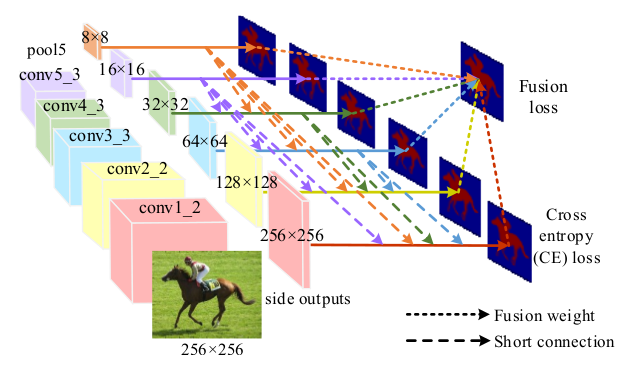AceCoooool / Dss Pytorch
Licence: mit
⭐️ PyTorch implement of Deeply Supervised Salient Object Detection with Short Connection
Stars: ✭ 158
Programming Languages
python
139335 projects - #7 most used programming language
Labels
Projects that are alternatives of or similar to Dss Pytorch
Openedu
📚 The Open Source Education Initiative – a repository with resources for 60+ engineering subjects. Let's make education more open and accessible! 🚀✨
Stars: ✭ 156 (-1.27%)
Mutual labels: jupyter-notebook
Fastbook
The fastai book, published as Jupyter Notebooks
Stars: ✭ 13,998 (+8759.49%)
Mutual labels: jupyter-notebook
Patch Based Texture Synthesis
Based on "Image Quilting for Texture Synthesis and Transfer" and "Real-Time Texture Synthesis by Patch-Based Sampling" papers
Stars: ✭ 159 (+0.63%)
Mutual labels: jupyter-notebook
Pikachu Detection
Detecting Pikachu on Android using Tensorflow Object Detection API
Stars: ✭ 157 (-0.63%)
Mutual labels: jupyter-notebook
Gasyori100knock
image processing codes to understand algorithm
Stars: ✭ 1,988 (+1158.23%)
Mutual labels: jupyter-notebook
Cartoonify
Deploy and scale serverless machine learning app - in 4 steps.
Stars: ✭ 157 (-0.63%)
Mutual labels: jupyter-notebook
Yolov4 Cloud Tutorial
This repository walks you through how to Build and Run YOLOv4 Object Detections with Darknet in the Cloud with Google Colab.
Stars: ✭ 153 (-3.16%)
Mutual labels: jupyter-notebook
Pythonrobotics
Python sample codes for robotics algorithms.
Stars: ✭ 13,934 (+8718.99%)
Mutual labels: jupyter-notebook
Yolo2
这个项目是基于论文YOLO9000: Better, Faster, Stronger的keras(backend:tensorflow)实现
Stars: ✭ 157 (-0.63%)
Mutual labels: jupyter-notebook
Machine Learning
机器学习&深度学习资料笔记&基本算法实现&资源整理(ML / CV / NLP / DM...)
Stars: ✭ 159 (+0.63%)
Mutual labels: jupyter-notebook
Covid19 mobility
COVID-19 Mobility Data Aggregator. Scraper of Google, Apple, Waze and TomTom COVID-19 Mobility Reports🚶🚘🚉
Stars: ✭ 156 (-1.27%)
Mutual labels: jupyter-notebook
Machine Learning Workflow With Python
This is a comprehensive ML techniques with python: Define the Problem- Specify Inputs & Outputs- Data Collection- Exploratory data analysis -Data Preprocessing- Model Design- Training- Evaluation
Stars: ✭ 157 (-0.63%)
Mutual labels: jupyter-notebook
Handyspark
HandySpark - bringing pandas-like capabilities to Spark dataframes
Stars: ✭ 158 (+0%)
Mutual labels: jupyter-notebook
Python Textualheatmap
Create interactive textual heat maps for Jupiter notebooks
Stars: ✭ 156 (-1.27%)
Mutual labels: jupyter-notebook
Tensorflow Dataset Tutorial
Notebook for my medium article about how to use Dataset API in TensorFlow
Stars: ✭ 158 (+0%)
Mutual labels: jupyter-notebook
Deep Q Learning
Tensorflow implementation of Deepminds dqn with double dueling networks
Stars: ✭ 158 (+0%)
Mutual labels: jupyter-notebook
Gpt2 Bert Reddit Bot
a bot that generates realistic replies using a combination of pretrained GPT-2 and BERT models
Stars: ✭ 158 (+0%)
Mutual labels: jupyter-notebook
DSS-PyTorch
PyTorch implement of Deeply Supervised Salient Object Detection with Short Connection
The official caffe version: DSS
Prerequisites
- Python 3
- Pytorch 0.4.1+
- torchvision
- visdom (optional for visualization)
- PyDenseCRF(optional for CRF post-process)
Results
The information of Loss:
Example output:
Note: here the "blur boundary" caused by bad combine method
Different connection output:
Some difference
- The original paper use:$Z=h(\sum_{i=2}^4 f_mR^{(m)})$,here we use $Z=h(\sum_{i=1}^6 f_mR^{(m)})$ in inference stage
Results Reproduct
| Dataset (MSRA-B) | Paper | Here (v1) | Only Fusion (v1) | Here (v2) | Only Fusion (v2) | Here(v2 700) |
|---|---|---|---|---|---|---|
| MAE (without CRF) | 0.043 | 0.054 | 0.052 | 0.068 | 0.052 | 0.051 |
| F_beta (without CRF) | 0.920 | 0.910 | 0.914 | 0.912 | 0.910 | 0.918 |
| MAE (with CRF) | 0.028 | 0.047 | 0.048 | 0.047 | 0.049 | 0.047 |
| F_beta (with CRF) | 0.927 | 0.916 | 0.917 | 0.915 | 0.918 | 0.923 |
Note:
- v1 means use average fusion , v2 means use learnable fusion
- You can try to use other "inference stragedy"(I think other combine can get better results --- here use sout-2+sout-3+sout-4+fusion --- you can just change self.select)
- v2 700 means training with 700 epochs. (I use pre-trained model by 500 epochs:so the optimizer is a little differnt to direct 700 eopch)
Usage
1. Clone the repository
git clone [email protected]:AceCoooool/DSS-pytorch.git
cd DSS-pytorch/
2. Download the dataset
Download the MSRA-B dataset. (If you can not find this dataset, email to me --- I am not sure whether it's legal to put it on BaiDuYun)
# file construction
MSRA-B
--- annotation
--- xxx.png
--- xxx.png
--- image
--- xxx.jpg
--- xxx.jpg
--- test_cvpr2013.txt
--- train_cvpr2013.txt
--- valid_cvpr2013.txt
--- test_cvpr2013_debug.txt
--- train_cvpr2013_debug.txt
--- valid_cvpr2013_debug.txt
3. Get pre-trained vgg
cd tools/
python extract_vgg.py
cd ..
4. Demo
pleease see demo.ipynb
Note:
- default choose: download and copy the pretrained model to
weightsdirectory
5. Train
python main.py --mode='train' --train_path='you_data' --label_path='you_label' --batch_size=8 --visdom=True --train_file='you_file'
Note:
-
--val=Trueadd the validation (but your need to add the--val_path,--val_fileand--val_label) -
you_data, you_labelmeans your training data root. (connect to the step 2) - If you Download the data to
youhome/data/MSRA-B(you can not "implicity" the path)
6. Test
python main.py --mode='test' --test_path='you_data' --test_label='your_label' --use_crf=False --model='your_trained_model' --test_file='you_file'
Note:
- only support
bath_size=1 -
--use_crf=True:means use CRF post-process
Note that the project description data, including the texts, logos, images, and/or trademarks,
for each open source project belongs to its rightful owner.
If you wish to add or remove any projects, please contact us at [email protected].




